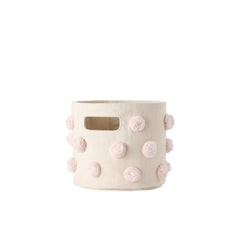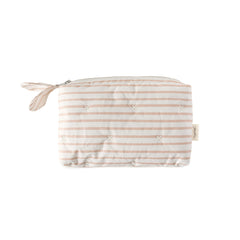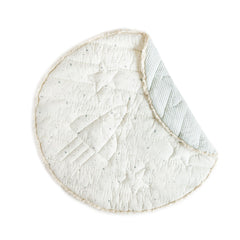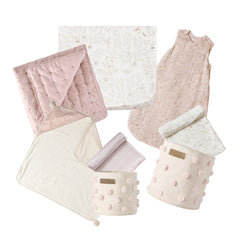When you and your baby are well-rested, you’re set up for success in all your daytime activities. So, it’s no surprise that many newborn parents work hard to figure out the best sleep habits and feeding schedules for their little ones. If you’re wondering whether or not the dream feed fits into your child’s sleep routine, you’ve come to the right place! In this article, we’ll walk you through what a dream feed is and why it’s something you might want to consider. We’ll also share some guidelines for when to start and when to drop dream feed. Finally, we’ll share a few of our favorite tips and tricks to help make dream feeds a breeze. With all this information in hand, you’ll be well equipped to try out dream feeding with your little one and explore if it’s the right fit for you!
Table of Contents
- What is a dream feed?
- Why dream feed?
- When to start dream feed
- When to drop dream feed
- Dream feed tips and tricks
What is a dream feed?
The term ‘dream feed’ was coined by Tracy Hogg, a registered nurse and best-selling author from the U.K, in the early 2000s. The concept is quite straightforward, although the term is used in slightly different ways by different people. In some contexts, the dream feed is simply the last feeding of the day. It typically occurs about 2 - 3 hours after the bedtime feeding which will usually be right around the time you are ready to go to bed. In this case, the baby may or may not be woken up for the feeding. In contrast, the term ‘dream feed’ can also sometimes be used more generally to refer to the practice of feeding a sleeping infant.
Why dream feed?
Regardless of how the term is used, the purpose of the dream feed remains the same: to help the infant sleep for longer periods of time and, in turn, ensure that the infant’s parents also get a longer stretch of uninterrupted sleep. Rather than wait for your baby to wake shortly after you fall asleep and ask for a feed, you’re providing it proactively before you go to sleep.

When to start dream feed
Dream feeds are best suited to babies between the ages of 0 and 6 months. So, if you want to introduce the dream feed, make sure you do it during this window. You might be wondering when during this 6-month window is the best time to introduce the first dream feed. This varies from baby to baby but, once your little one can sleep for longer stretches of time (4-5 hours) without needing a feeding, they are likely ready to give dream feeding a try!
When to drop dream feed
Many new parents wonder when to drop dream feed. It’s an important question because dropping the dream feed at the right time can help you set your child up for sleep success in the future. It is recommended that you phase out dream feeds by around 6 months of age. This is because, at this age, the dream feed can start to become a wake habit. This means your child may begin to wake around the same time every night in anticipation of the feed even if they aren’t particularly hungry.
In addition to age, if you’re wondering when to drop dream feed, pay attention to how interested your child is in their morning feed. If they are starting to lose interest in their morning milk feed, this is a good sign that it’s time to start scaling back on nighttime feedings.

Now that we know when to drop dream feed, let’s talk about how to drop it. Like many of the transitions you and your baby will go through together, it’s best to take it slow and steady. So, instead of stopping the dream feed cold turkey, try scaling back slowly. If you are breastfeeding, you can do this by gradually reducing the length of the feeding by two minutes at a time. If you are bottle feeding, you can do this by gradually reducing the volume of the feeding by 1 ounce at a time. Repeat this scaling back process every few nights before finally dropping the dream feed altogether.
Dream feed tips and tricks
If you’re used to feeding your baby when they’re wide awake, hungry, and asking for milk, the dream feed will look a little bit different. Here are some tips, tricks, and techniques you can try out if this is your first time feeding your baby while they are asleep or drowsy:
- Rouse your little one just enough to get them to latch onto the bottle or breast. You want to try and keep your baby as drowsy as possible.
- You can initiate the rooting reflex by stroking your little one’s cheek. Using this technique, some parents can even successfully feed while their baby continues to sleep.
- Elevating your child’s head slightly can also help them latch to the breast or bottle while in a drowsy state.
- Make sure the nursery is quiet and dark during the dream feed.
- Avoid unswaddling your little one or taking them out of their sleep bag during the feeding.
- Work on your own sleep routine as well to sync up with your baby’s dream feed so you can get the longest stretch of rest possible. Have a routine in place that will help you fall asleep shortly after you finish up the dream feed.

With so many different sleep and feeding routines out there, it can be hard to know what is right for you and your baby. Dream feeding is just one technique that can help you as you navigate the first few months of life with your baby. Like most parents, you’ll find helpful tips, tricks, and information from a variety of different sources so don’t get discouraged if dream feeding isn’t a fit for you. With a little trial and error, you’ll discover the right routine to help you and your child get as much restful sleep as possible!






